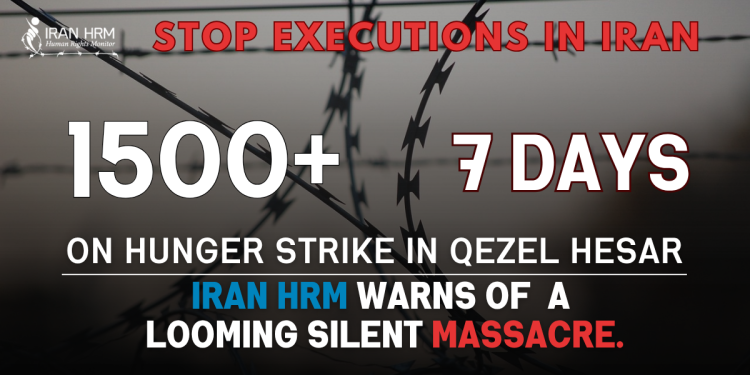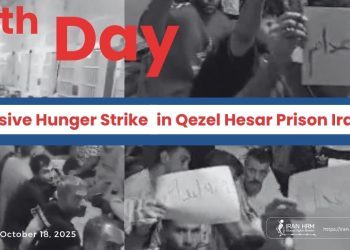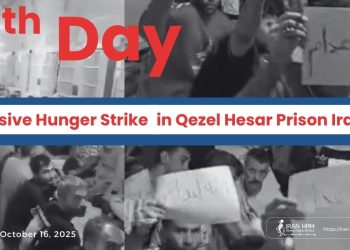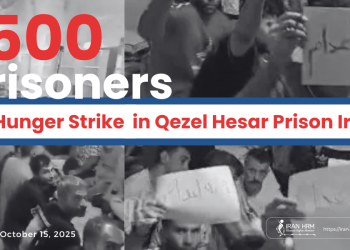Introduction
After six days of a large-scale hunger strike at Qezel Hesar Prison in Karaj, prisoners sentenced to death announced on October 19, 2025 (27 Mehr 1404) that they would temporarily suspend their strike to give authorities a chance to fulfill their promises. This decision followed a rare visit by judicial officials and their pledge to halt executions and review the country’s drug law. This report examines how the solidarity of prisoners, family protests, and international reactions forced this unprecedented retreat by Iranian authorities.
Inside the Prison
The hunger strike began on October 12, 2025, when over 1,500 inmates—many with their lips sewn shut—gathered in Unit 2 to protest the relentless wave of executions. Banners reading “No to Execution” and “Do not come to our funerals, come to our aid” were hung in the corridors. Authorities cut off water supplies, disrupted phone access, and denied medical care to several prisoners. Despite such pressure, collective resistance continued. One inmate said in a voice message: “We have sewn our lips not for ourselves, but to stop death—for the right of our children to live.”
Government Promises and Prisoners’ Response
On October 19, a delegation including Hayat-ol-Gheyb, Head of Tehran Provice Prisons, Heshmati, Chair of Tehran Organization of Prisons, Allah Karam Azizi, current head of Qezel Hesar prison and a judiciary representative named Asadi visited the ward, promising that “no executions will take place for several months.” Six prisoners who had been moved to solitary confinement were returned to the ward. When officials warned that “continuing the strike could be seen as collusion with opposition groups,” prisoners replied: “You are the liars, not us. The death law was unjust from the start; this country does not belong only to you.”
Family and Civil Society Solidarity
Simultaneously, families of death-row inmates gathered outside the Iranian parliament, chanting “Do not execute.” Security forces violently dispersed them, but citizens expressed support by honking their car horns in solidarity. On social media, hashtags #NoToExecution and #QezelHesar trended widely. Thousands inside and outside Iran shared images of prisoners with sewn lips. International campaigns such as Stop Executions in Iran organized rallies in Paris, Berlin, Stockholm, and Vancouver, amplifying the message of resistance.
Support from Other Prisoners
Inside Qezel Hesar, political prisoner Saeed Masouri voiced support for the striking inmates, writing: “They love life so deeply that they are willing to die for the right to live. The regime of death fears such love.” Another group of political prisoners issued a statement declaring: “We have sewn our lips to say that execution is no solution. This October has been the bloodiest month for those on death row.”
International Reactions
The publication of videos and testimonies from Qezel Hesar triggered a wave of international outrage:
• United States: In an official statement, the U.S. announced new human rights sanctions against Qezel Hesar Prison, saying: “Qezel Hesar Prison is being sanctioned for its inhumane treatment of striking inmates. We stand with the people of Iran and their right to live without fear.” (Source: U.S. Department of State – Iran Human Rights Sanctions)
• European Union: The EU urged Tehran to halt executions, warning that “Any expansion of economic relations with Iran depends on a complete end to capital punishment.” (Source: European External Action Service – Statement on Iran Executions)
• Amnesty International: On October 19, Amnesty stated: “The Iranian authorities use the gallows to instill fear. We call for an immediate halt to all death sentences and for independent monitors to access prisons.” (Source: Amnesty International – Iran: Stop Executions)
• United Nations: UN High Commissioner for Human Rights Volker Türk reiterated his call for a global moratorium on executions, saying: “The mass executions in Iran have surpassed the threshold of serious crimes and have become a tool of social intimidation.” (Source: OHCHR – Statements by the High Commissioner)
• Global Figures: Over 300 global figures, including Marie-Laur Lanson, Tony Lloyd, Cherie Blair, and Nobel Peace laureates Jody Williams and Leymah Gbowee, signed a joint declaration demanding an immediate halt to executions and release of protest prisoners. “The unrestrained surge in executions in Iran signals readiness for crimes on a broader scale. The international community must act now, before it is too late.”
Human Rights Analysis
- The Qezel Hesar hunger strike marks a turning point in Iran’s anti-execution movement — the first large-scale unity between political and non-political prisoners.
2. The authorities’ promises remain unenforceable without international oversight.
3. The convergence of domestic activism, civil campaigns, and international condemnation demonstrates that the No to Execution movement has evolved into a global demand for the right to life.
4. The regime’s retreat was the direct result of pressure from below (prisoners’ resistance and solidarity) and pressure from above (international and public scrutiny).
Conclusion and Call to Action
The temporary suspension of the strike serves as a test of the regime’s credibility. Qezel Hesar has become a symbol of defiance against the policy of death and a cry for life. The international community must transform this moment into concrete action:
1. Dispatch a UN fact-finding mission to monitor prison conditions and halt executions.
2. Impose targeted sanctions on judiciary and prison officials responsible for repression.
3. Guarantee free communication between families, media, and civil society organizations.
4. Condition all political and economic relations with the ruling regime in Iran on a complete suspension of capital punishment.
Qezel Hesar is no longer just a prison — it is the voice of global conscience, a cry declaring that even in the darkest cells, the right to life cannot be silenced.
Stop Executions in Iran: Preventing Another Massacre in Silence







